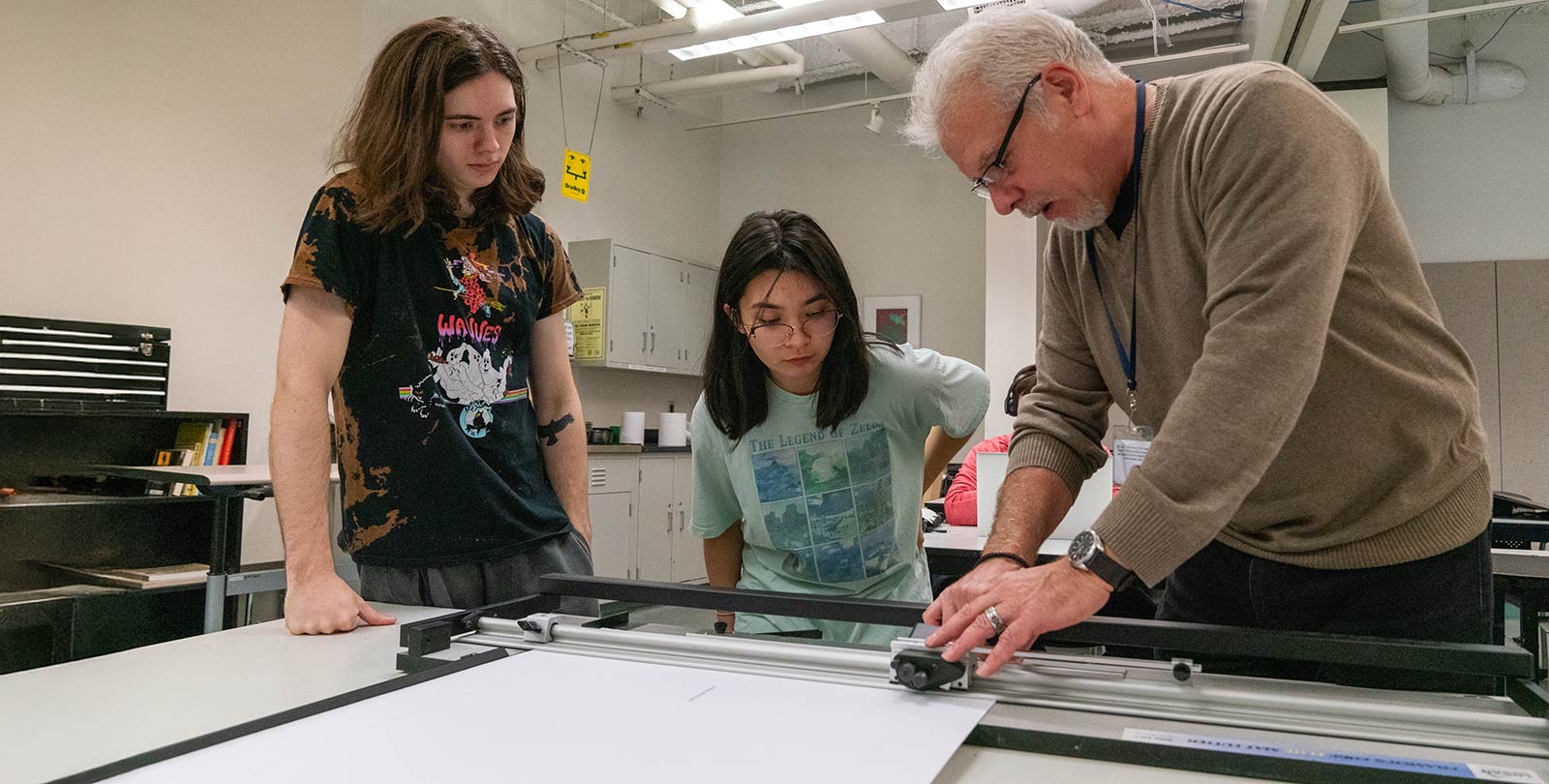What You Will Learn
The Interior Design track offers a diverse and interdisciplinary studio environment whereby students gain insight to multiple areas of design and their influences within industry, society and profession. Architecture, Interior Design, Industrial Design, Fashion Design, Fashion Merchandising are areas that make up the studio culture in the Design Program at CCM.
The Interior Design track provides a comprehensive foundation for students transferring to four-year colleges and universities to continue their studies and pursue a Bachelor of Science (B.S.) or a Bachelor of Fine Arts (BFA) degree in Interior Design. Contemporary and traditional skill-sets acquired at CCM provide the student with immediate opportunities in industry as CAD Designers, Interior Design Assistants, Color and Materials Designers, Model Home Merchandisers, Design Salespeople and Revit Modelers.
Curriculum
Our Interior Design program features a combination of a 30-credit design core and ten credits towards the interior design track.
Core courses include 2D For Designers, Color Theory, Design Concepts, Design Rendering, Drawing, History of Design and a final Portfolio Preparation course enabling you to have your work presentable for professional job applications or future educational goals. The track focuses on CAD and Drafting courses.
This is in addition to the 20-credit general education foundation for all design majors at CCM.
Careers in the Field
A degree in Interior Design will prepare you for the following careers.
Associate Degree:
- CAD Modeler/Designer/Drafter
- Color and Material Designer
- Interior Decorator
- Interior Design Assistant
- Interior Design Consultant
- Model Home Merchandiser
- Revit Drafter/ Modeler
Bachelor’s Degree:
- Certified kitchen designers
- Corporate designers
- Furniture arrangers
- Healthcare designers
- Home lighting advisers
- Interior Designer
- Kitchen and bath designers
- Kitchen designers
- Sustainable designers
- Universal designers
Furthering your education with completion of a bachelor’s degree from a four-year college or university may open additional doors as a:
- Interior Designer
- Certified Kitchen Designer
- Corporate Designer
- Healthcare Facility Designer
- Home Lighting Adviser
- Kitchen And Bath Designer
- Sustainable Designer
- Universal Designer
Why Study Interior Design at CCM?
CCM has designated studio classrooms with state-of-the-art equipment and software available to all design students.
- The class size average is 12:1 in the studio; this ratio fosters a mentoring relationship between the student and professor.
- Studios are supplied with materials and resources that allow extensive opportunities for creative exploration in research and process.
- Faculty are dedicated and highly accomplished. Many maintain professional practice, bringing real-world problems to the design curriculum and classroom.
The program is accredited by the Middle States Association of Colleges and Schools.
Where You Can Go
Upon completion of the Associate in Fine Arts degree (AFA), the majority of Interior Design track students transfer to earn a bachelor’s degree: Bachelor of Fine Arts (BFA) or a Bachelor of Science (B.S.). CCM graduates have transferred to the following institutions:
- Fashion Institute of Technology (FIT)
- Thomas Jefferson University
- Kean University
- Marywood University
- New Jersey Institute of Technology (NJIT)
- New York School of Interior Design (NYSID)
- Parsons School of Design
- Pratt Institute
- Ringling College of Art and Design
- Savannah College of Art and Design (SCAD)
- SUNY Fashion Institute of Technology
Visit our Transfer Services page for more information.
Credit, non-credit internship experiences and job search support are facilitated through our Office of Career and Transfer Services, where you can also learn how to build a resume, and receive the tools to help you with interviewing skills to succeed! Visit our Career Services page for additional information.
Paying For Your Interior Design Education
Earning an associate degree in design is a powerful investment that will pay off over the course of your life, in both increased earnings and job satisfaction. But what is the upfront cost, and how do you afford it?
There’s good news: Money is available to help you pay for school! Our Financial Aid staff can provide lots of information about the process of finding funds to help pay for your education.
Featured Courses
Basic Drafting
Basic Drafting is a beginner’s course that provides a solid foundation for all design and engineering courses. The study of materials and techniques in this course introduces students to the many forms of graphical communication and how best to convey their ideas in a graphical form. A variety of techniques are explored from pencil on vellum to pen on Mylar with further rendering techniques offered to focus on the individual’s Design discipline.
Design Concepts I
A detailed exploration of scale and proportion through two and three-dimensional sketch problems varying in levels of complexity and duration. Design projects explore relationships between historical and cultural systems and human proportion. Verbal and graphic communication skills are emphasized as a method of articulating the development of visual concepts and solutions to design problems. Communication tools such as perspective are explored in detail. Projects, which include architectural, interior design, fashion and industrial design are reviewed through juried presentations.
Advanced CAD 3D Modeling
Upon completing CAD I and CAD II, students are next expected to acquire advanced skills in 3D modeling. This course expands on the lessons learned in CAD I and II and teaches the students valuable skills that are critical to the product and build environments. Working with advanced digital imaging software like Adobe Revit, students learn to generate modeled images with a critical determination.
Resources





